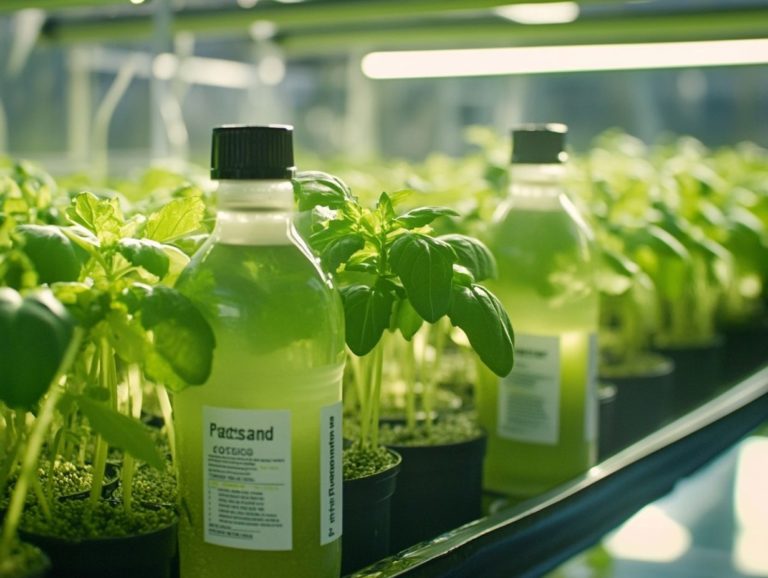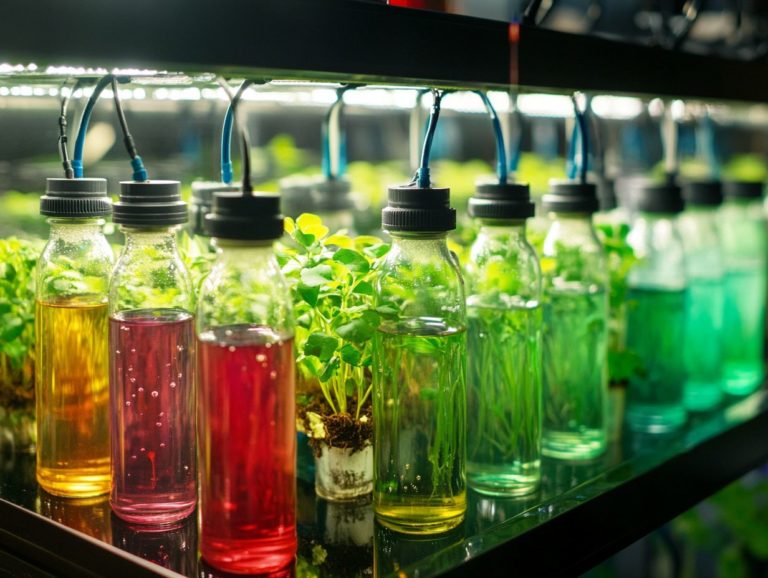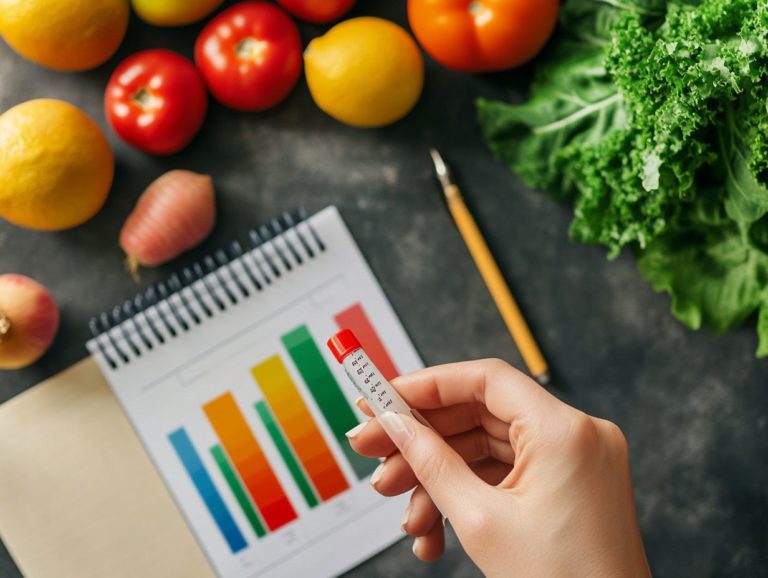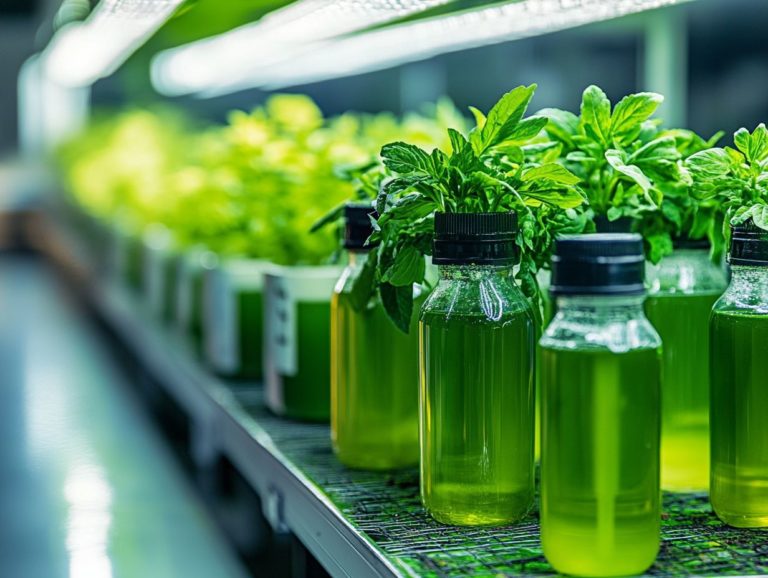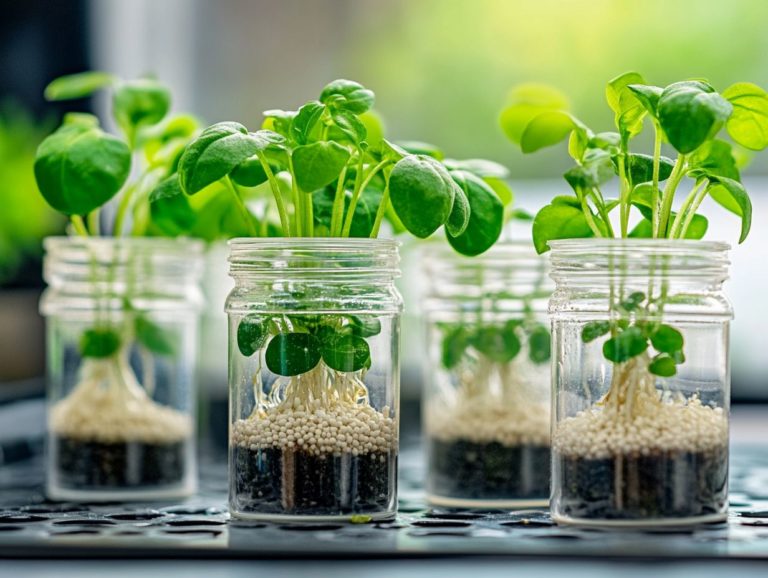Balancing Nutrients: A Hydroponic Guide
Ready to transform your gardening experience? Hydroponics has revolutionized your approach to growing plants, enabling efficient cultivation without the constraints of soil.
At the heart of successful hydroponic gardening lies careful management of nutrients. This directly influences both plant health and yield.
This guide delves into the essentials of nutrient balance within hydroponic systems. It helps you understand exactly what your plants require while equipping you to identify common nutrient deficiencies.
You’ll discover effective methods for maintaining nutrient balance over time. Whether you’re just starting out or are already an experienced grower, this guide provides valuable insights to elevate your hydroponic gardening journey!
Contents
- Key Takeaways:
- Nutrient Balance in Hydroponic Systems
- Choosing the Right Nutrients for Your Plants
- Methods for Balancing Nutrients in Hydroponic Systems
- Common Nutrient Deficiencies and How to Address Them
- Maintaining Nutrient Balance in the Long Term: A Key to Successful Urban Farming
- Frequently Asked Questions
Key Takeaways:
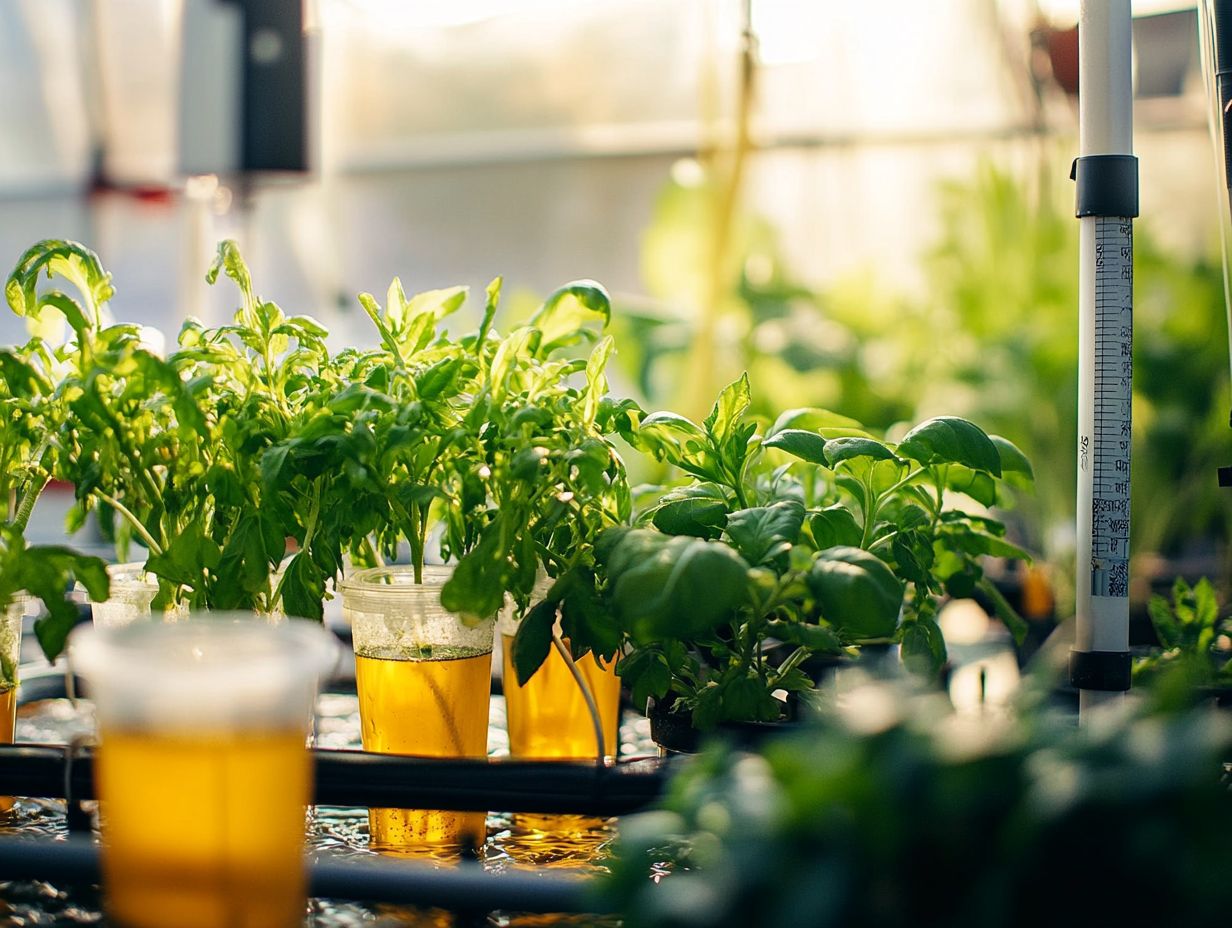
- Understand basic principles of hydroponics and how it differs from traditional soil-based gardening.
- Choose the right nutrients for your plants based on their specific nutrient needs and the type of hydroponic system being used.
- Use a combination of top-down and bottom-up approaches to maintain nutrient balance in your hydroponic system and prevent common deficiencies.
What is Hydroponics?
Hydroponics presents you with an innovative method of cultivating plants without soil. This utilizes nutrient solutions to deliver essential macronutrients and micronutrients directly to the roots.
This approach not only enhances water efficiency but also shines in urban farming settings where space is at a premium. Traditional agriculture might not be feasible in these areas.
By exploring a variety of hydroponic systems, such as deep water culture, nutrient film technique, and aeroponics, you can tailor your strategy to meet the specific needs of your crops. These techniques accelerate plant growth and significantly reduce the risk of pests and diseases commonly associated with soil.
The hydroponic method allows for year-round cultivation, ensuring you can provide fresh produce in urban areas that often depend on distant suppliers. Overall, the benefits of this method include reduced resource consumption and increased yields, positioning it as a sustainable alternative to conventional farming practices.
Nutrient Balance in Hydroponic Systems
Achieving optimal nutrient balance in hydroponic systems is essential for your plants’ successful growth. It directly impacts nutrient absorption and overall health.
By mastering the maintenance of the right acidity levels and electrical conductivity, you ensure that macronutrients like nitrogen, phosphorus, and potassium, along with vital trace minerals, are efficiently utilized by your plants.
This proactive nutrient management enhances crop production and minimizes the risk of nutrient deficiencies.
Understanding Plant Nutrient Needs
Understanding the nutrient needs of your plants is crucial for thriving hydroponic cultivation. You must maintain a delicate balance of macronutrients like nitrogen, phosphorus, and potassium alongside essential micronutrients such as calcium, magnesium, and iron.
These elements are vital for your plants to flourish. Without the right nutrients, you risk stunted growth and disappointing crop yields, which underscores the importance of consistently monitoring and managing your nutrient solutions in the hydroponic system, including understanding the role of micronutrients in hydroponics.
Each nutrient has a distinct role to play: nitrogen fuels leafy growth, phosphorus champions root development and flowering, while potassium boosts overall vigor and fortifies disease resistance. In your hydroponic setup, deficiencies often show up as yellowing leaves or slowed growth, typically stemming from imbalanced nutrient solutions. To ensure you’re mixing your nutrients correctly, check out this guide on how to mix hydroponic nutrients like a pro.
To keep tabs on these nutrient levels effectively, consider using tools like EC meters and pH testers. This ensures that your nutrient solution stays within optimal ranges.
Regularly inspecting your plant health and making proactive adjustments to nutrient concentrations can dramatically enhance vitality and maximize your yields.
Start your hydroponic journey today and watch your garden flourish!
Choosing the Right Nutrients for Your Plants
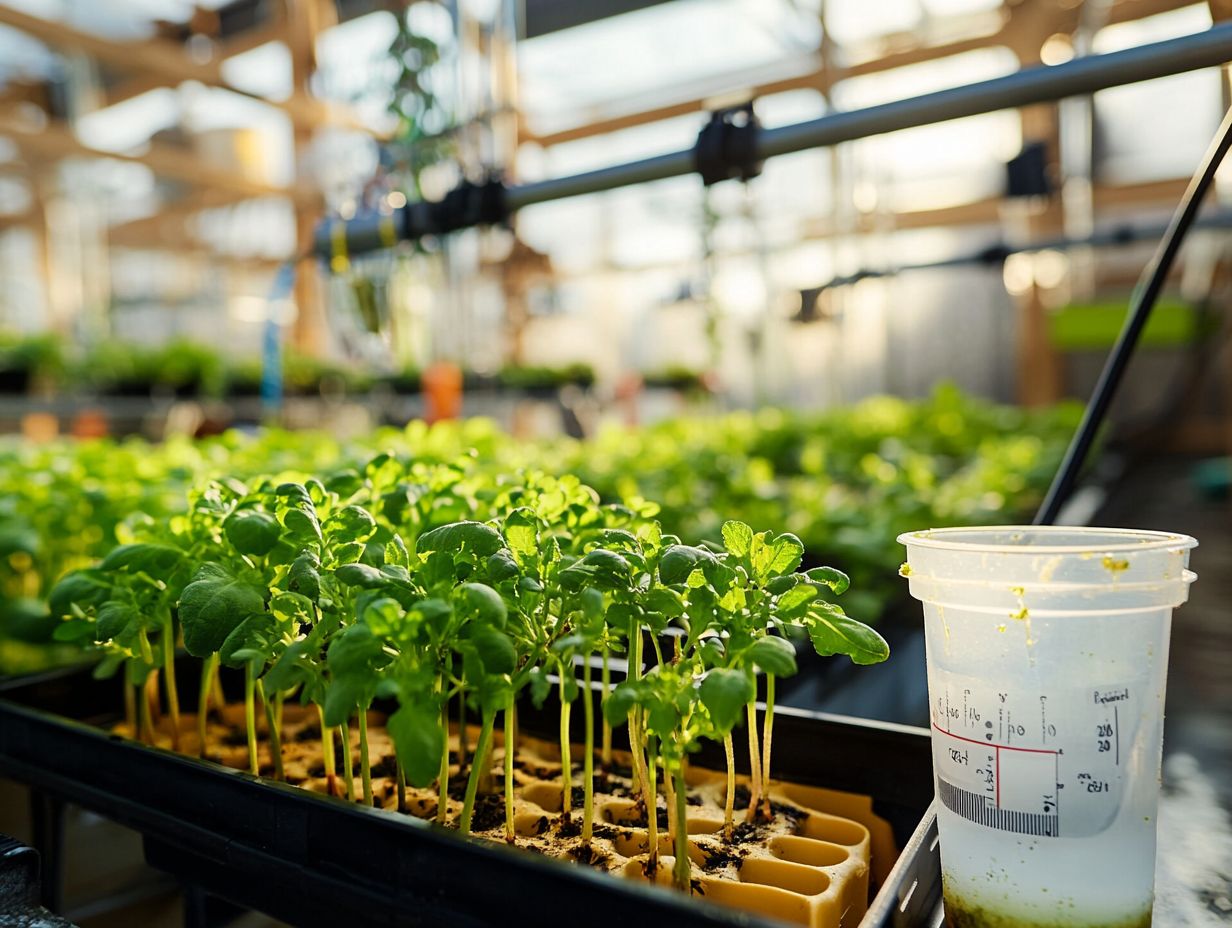
Selecting the right nutrients for your plants in a hydroponics system is paramount for achieving optimal growth and maintaining a delicate nutrient balance. This process requires a deep understanding of the specific needs of the plants you are nurturing, be it tomatoes, lettuce, or spinach.
Ensure that your nutrient solutions deliver the necessary macronutrients and micronutrients. Macronutrients are nutrients plants need in larger amounts, while micronutrients are needed in smaller amounts. By employing a well-balanced fertilizer strategy, you can boost the health of your plants and enhance the efficiency of your hydroponic systems for leafy greens.
Types of Nutrients and Their Functions
The primary nutrients essential for healthy plant growth in hydroponics include macronutrients nitrogen, phosphorus, and potassium alongside important minerals like iron and calcium. Each of these nutrients plays a specific role in plant metabolism, influencing everything from root development to the flowering and fruiting stages.
It’s vital to supply these nutrients adequately through nutrient solutions to achieve optimal crop production. For instance, nitrogen is essential for leaf and stem growth; it forms the backbone of proteins and chlorophyll, which are critical for photosynthesis. Phosphorus enhances root development and facilitates energy transfer within the plant, directly affecting the flowering and fruiting process.
Potassium bolsters overall plant health by regulating water usage and enzyme activity. Meanwhile, trace minerals, although needed in smaller quantities, are no less important. Iron and calcium are essential for chlorophyll synthesis and maintaining cell wall structure, respectively.
By integrating these nutrients into your hydroponic systems via well-balanced nutrient solutions, you’ll ensure that your plants receive everything they need for robust growth and impressive yields.
Methods for Balancing Nutrients in Hydroponic Systems
Balancing nutrients in hydroponic systems is entirely within your grasp, thanks to several effective methods. Consistent nutrient testing, along with careful adjustments of pH levels and electrical conductivity, give you the power to monitor nutrient solutions in real time.
Act now! This careful approach ensures your plants get the perfect nutrient balance they crave. By integrating these techniques, you can boost the efficiency and productivity of your hydroponics system, especially by Understanding Hydroponic Nutrient Solutions.
Top-Down and Bottom-Up Approaches
In hydroponics, you can approach nutrient management from both top-down and bottom-up perspectives, each offering distinct advantages for maintaining nutrient balance within your system. The top-down approach focuses on broader environmental factors that influence nutrient availability, such as water quality and your overall system design.
The bottom-up approach focuses on the specific nutrient needs of individual plants, enabling you to meet those needs with tailored nutrient solutions. By integrating these two methods, you can develop a comprehensive nutrient management strategy that maximizes plant health and growth.
A top-down analysis might reveal the need to adjust the pH or conductivity of your water, while the bottom-up methodology can pinpoint the specific micronutrients that certain plants are lacking. Challenges may arise when discrepancies occur between system-wide goals and individual plant needs, necessitating careful calibration on your part.
However, by harmonizing these approaches, you can ensure robust nutrient delivery that supports the diverse life cycles of your plants and enhances overall yield and quality in your hydroponic systems.
Ready to optimize your hydroponic garden? Start selecting your nutrients today!
Common Nutrient Deficiencies and How to Address Them
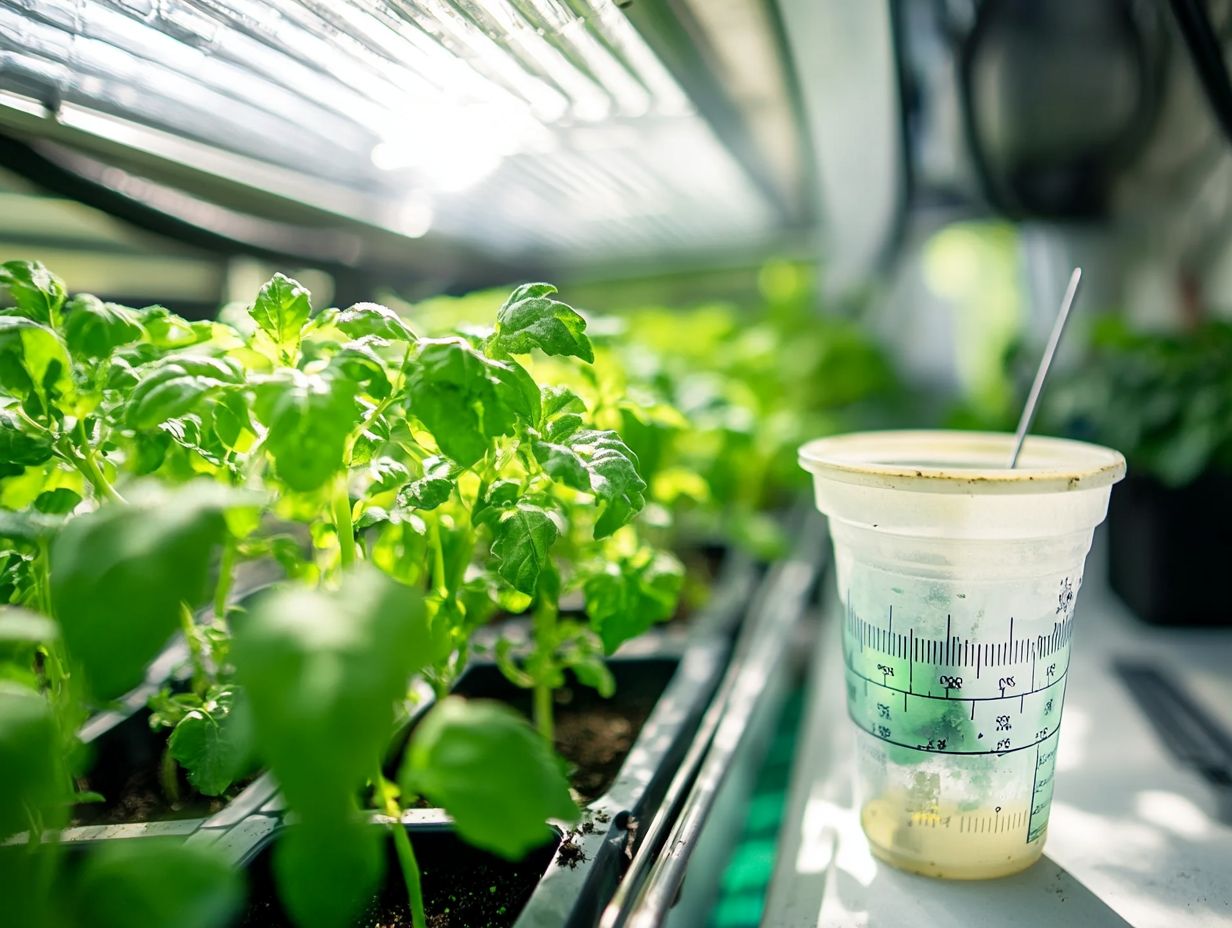
Common nutrient deficiencies in hydroponic plants can significantly hinder growth and yield. Recognizing and addressing these issues swiftly is crucial for keeping your plants thriving.
An imbalance in liquid fertilizers or incorrect pH levels can impede nutrient absorption. This results in telltale signs like yellowing leaves or stunted growth.
Spotting these deficiencies early and applying the right fertilizers or adjusting your nutrient solutions accordingly can effectively restore the essential elements necessary for robust plant development.
Identifying and Solving Nutrient Imbalances
Identifying and addressing nutrient imbalances in hydroponic systems is essential for promoting nutrient absorption. Regular nutrient testing, paired with diligent monitoring of pH levels, gives you the power to catch imbalances early and prevent potential growth setbacks.
Understanding the specific needs of your plants is vital. Adjusting nutrient solutions accordingly helps create an amazing environment for your plants.
Visual symptoms help in recognizing nutrient deficiencies. Yellowing leaves might signal a nitrogen shortage, while purple veins could indicate low phosphorus.
It’s important to pay attention to these signs. Stunted growth or lackluster flowering means you should make timely adjustments.
Conducting routine tests for key nutrients like potassium, calcium, and magnesium allows you to take a proactive approach in maintaining balance in your hydroponics system.
If you discover any imbalances, corrective actions might involve modifying the liquid fertilizers concentration or introducing specific supplements. This ensures healthy plants thrive under optimal conditions.
Maintaining Nutrient Balance in the Long Term: A Key to Successful Urban Farming
Maintaining a balanced nutrient profile over the long term is essential for sustainable nutrient management in hydroponics systems. This ensures your plants not only survive but thrive with impressive yields.
You need to monitor carefully. Fine-tune nutrient solutions based on plant growth cycles and their evolving nutrient requirements, including essential trace minerals.
By embracing proactive strategies, you can cultivate vibrant, healthy plants that consistently deliver robust harvests season after season, especially when focusing on nutrient balance.
Tips for Sustainable Nutrient Management in Hydroponics
Implementing sustainable nutrient management practices optimizes nutrient balance in your hydroponics system. Enhance water efficiency and overall productivity by utilizing organic fertilizers and recycling nutrient solutions.
Adopting advanced monitoring technologies minimizes waste and ensures that resources are used efficiently. Ultimately, this fosters a healthier growing environment for crops like tomatoes and lettuce.
Regular nutrient testing and employing precision agriculture techniques significantly improve the accuracy of your nutrient applications. Tailored nutrient delivery meets the specific needs of your crops.
This includes monitoring of pH levels and electrical conductivity, which help reduce excess runoff.
Leveraging smart irrigation systems not only conserves water but also curtails nutrient leaching into waterways. Use data analytics to monitor nutrient levels in real time, enhancing nutrient absorption and enabling proactive adjustments.
By embracing these innovative strategies, you can propel the hydroponics industry toward sustainability while achieving a remarkable increase in crop production, crop yield, and quality.
Frequently Asked Questions
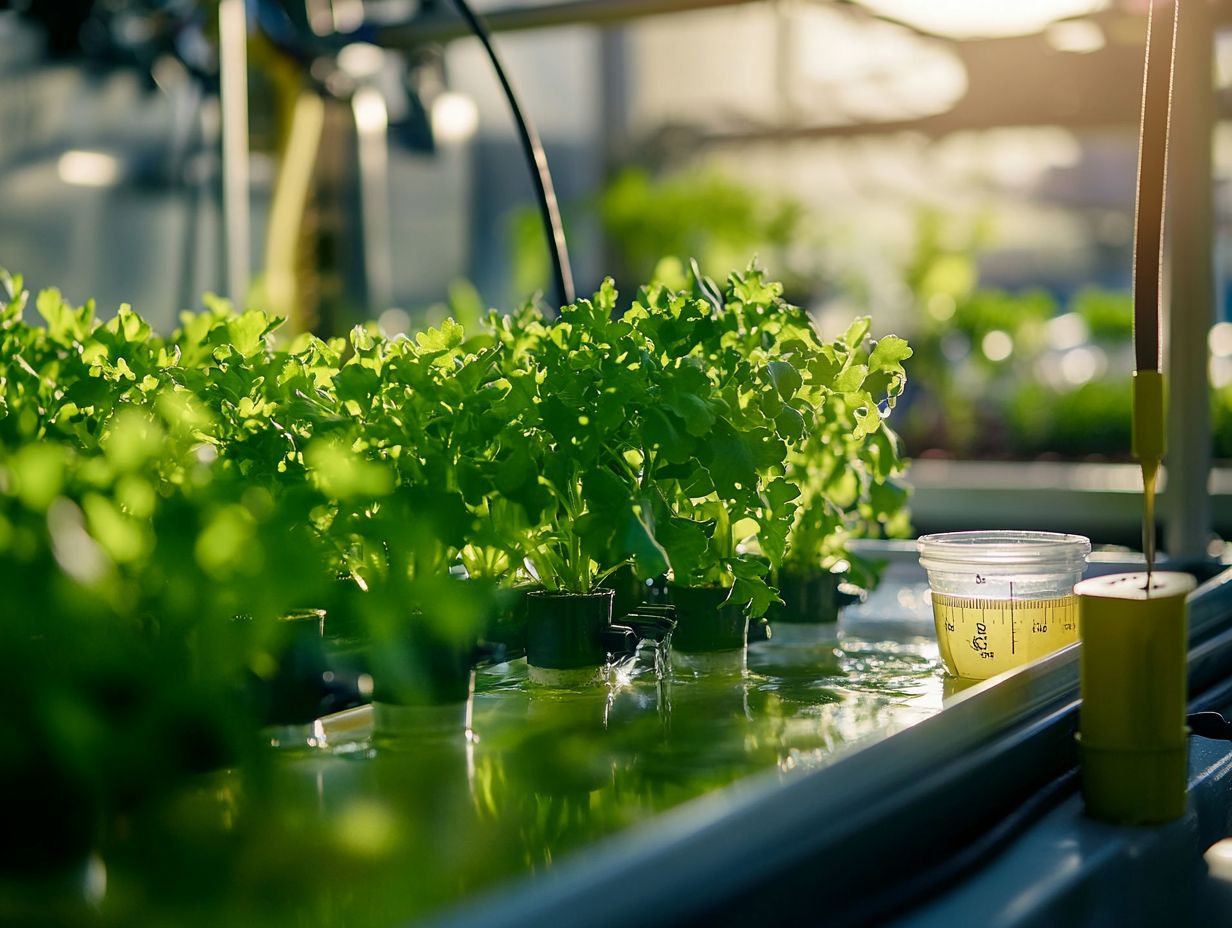
What is Hydroponic Farming?
Hydroponic farming is a method of growing plants in nutrient-rich water instead of soil. This innovative approach helps ensure plants get all the essential nutrients they need to thrive.
What Key Nutrients Do Hydroponic Plants Need?
The primary nutrients for hydroponic plants are nitrogen, phosphorus, and potassium, commonly referred to as NPK. Micronutrients like calcium, magnesium, and iron are also vital for healthy growth.
How Can I Test and Adjust Nutrient Levels?
Use a pH meter and a conductivity meter to test nutrient levels in your hydroponic system. These tools measure the pH and nutrient strength, helping you make necessary adjustments.
What Common Mistakes Should I Avoid?
Avoid over or under-fertilizing, and regularly monitor pH and electrical conductivity (EC) levels. Stick to the recommended nutrient ratios to prevent deficiencies.
Can I Use Organic Nutrients?
Yes, organic nutrients and fertilizers can be used in hydroponics. Keep in mind that they may not dissolve as easily as synthetic options, so you ll need to monitor and adjust more frequently.
How Often Should I Change the Nutrient Solution?
The frequency of changing the nutrient solution depends on your plants, system size, and water quality. Generally, aim to change it every 1-2 weeks, but monitor regularly and adjust as necessary.

